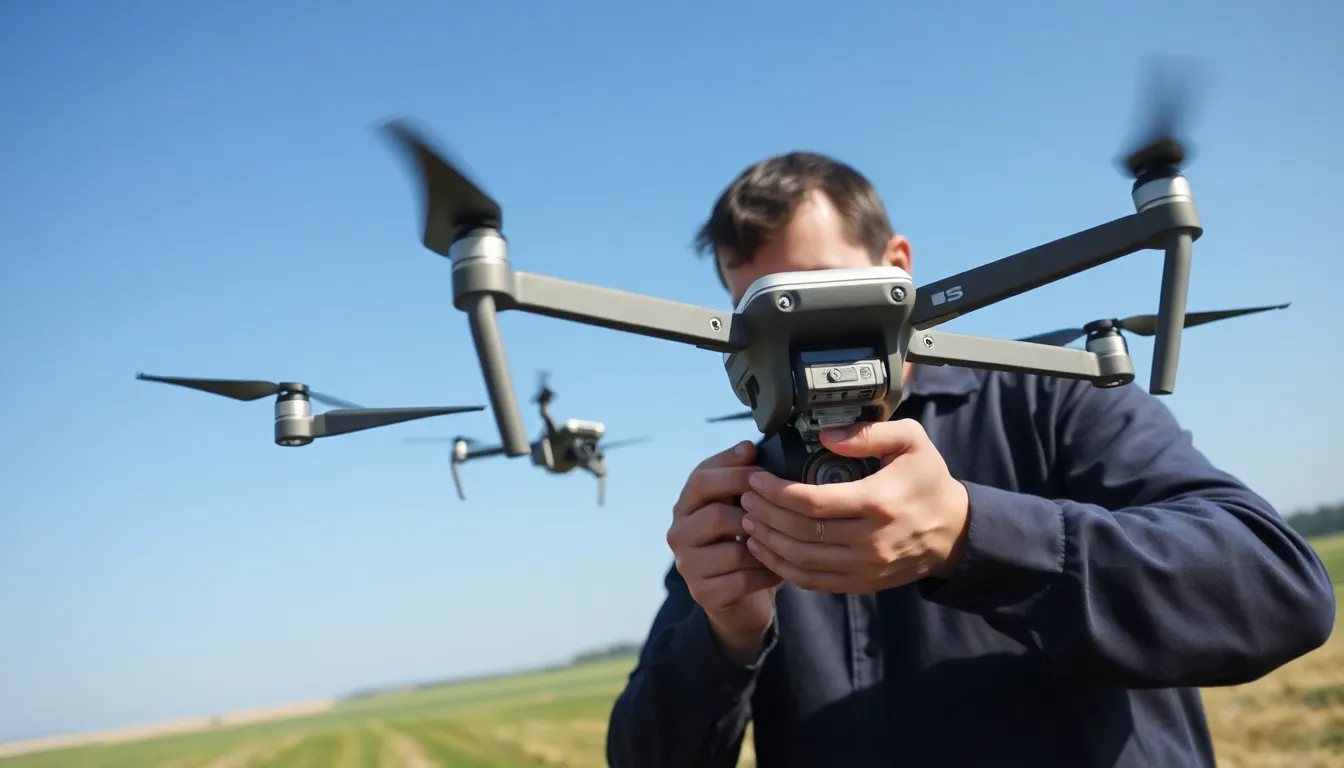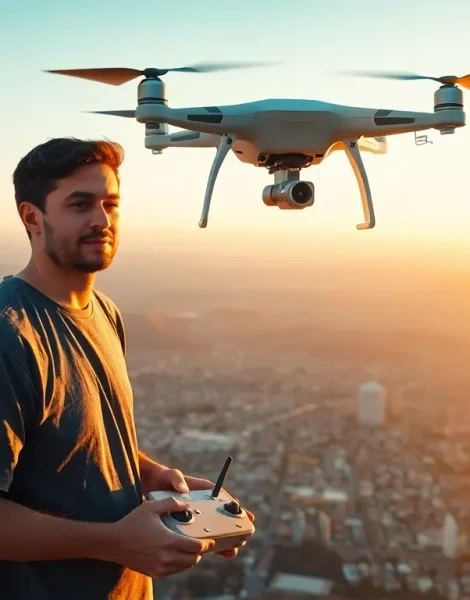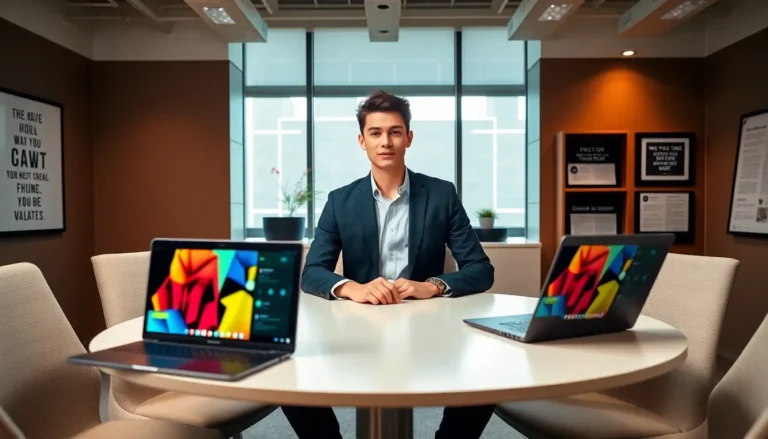In a world where everyone’s a photographer thanks to smartphones, drone photography takes the art to new heights—literally! Imagine capturing breathtaking landscapes, vibrant cityscapes, or even your neighbor’s questionable backyard BBQ from above. With the right techniques, anyone can transform ordinary scenes into extraordinary visual stories that’ll have friends saying, “How’d you get that shot?”
Table of Contents
ToggleOverview of Drone Photography Techniques
Capturing stunning aerial images with drones involves various techniques that enhance photo quality and creativity. Understanding composition plays a vital role; it’s essential to apply principles such as the rule of thirds and leading lines. These techniques guide viewers’ attention to focal points within the frame.
Utilizing different flight modes can also create unique perspectives. For instance, an orbit flight mode allows the drone to circle a subject, while a follow-me mode captures dynamic action shots. Taking advantage of these settings maximizes creative options during shoots.
Lighting influences drone photography significantly. Golden hour, typically the hour after sunrise and before sunset, provides optimal lighting for ethereal landscapes. Good usage of natural light captures vivid colors and highlights.
Adjusting camera settings can improve picture quality. Setting the ISO low reduces noise, while a higher shutter speed minimizes motion blur, ensuring sharp images. Manual control over exposure and focus provides greater artistic freedom.
Experimenting with angles can yield striking results. Shooting directly overhead gives a bird’s-eye view, while lower angles emphasize foreground subjects. Multidimensional compositions provide rich visual narratives.
Planning locations assists in finding unique vantage points. Researching scenic areas ahead of time allows photographers to identify points of interest. Utilizing mapping apps helps navigate to ideal shooting locations easily.
Practicing drone maneuvers enhances skill and confidence. Skillful flying allows an operator to execute complex shots with precision. Regular practice fosters a better understanding of drone capabilities and expands creative horizons.
Essential Equipment for Drone Photography

Selecting the right equipment is vital for successful drone photography. Quality drones typically feature high-resolution cameras and advanced stabilization systems that produce stunning images.
Choosing the Right Drone
Consider flight time, camera quality, and ease of use when choosing a drone. Battery life varies significantly among models, generally ranging from 20 to 30 minutes. Sensors enhance stability and image clarity, while 4K cameras capture detailed visuals. Portability also plays a role; compact drones are easy to transport yet may compromise features compared to larger models. Researching brands and reviews provides insights into dependable options that meet specific needs.
Camera Settings for Optimal Results
Adjusting camera settings dramatically affects photo quality. ISO influences sensitivity to light; keep it low for brighter conditions and higher for low light. Shutter speed controls motion blur so faster speeds capture sharp images of moving subjects. Aperture settings affect depth of field; a wider aperture creates a soft background while a narrower aperture increases focus on expansive scenery. Utilizing RAW format offers more editing flexibility, allowing for greater post-processing adjustments. Experimentation with these settings improves overall photography skills and results.
Composition Strategies in Drone Photography
Composition greatly influences the impact of aerial images. Understanding and applying key composition techniques can elevate drone photography to new heights.
Rule of Thirds and Leading Lines
Utilizing the rule of thirds can guide the viewer’s eye. Photographers should imagine a grid over their frame, dividing it into nine equal parts. Placing focal points along these lines or intersections enhances visual interest. Leading lines also play a crucial role in guiding the viewer toward a subject. Roads, rivers, or rows of trees can lead the eye toward the main focus. Combining these techniques fosters balance and directs attention effectively, making images more engaging.
Creating Depth and Perspective
Creating depth adds dimension to drone shots. Incorporating foreground elements like trees or buildings makes an image feel three-dimensional. This technique enhances spatial awareness, inviting viewers to explore the scene. Varying altitude also impacts perspective; shooting from different heights showcases landscapes in new ways. Experimenting with angles can further create dynamic compositions. Layers within an image add richness, encouraging viewers to linger on the details while appreciating the overall scene.
Advanced Techniques for Stunning Images
In this section, advanced techniques enhance the stunning capabilities of drone photography for inspired results.
Aerial Panoramas and HDR Photography
Aerial panoramas elevate landscape photography by capturing extensive vistas. Photographers can stitch multiple images together for a seamless, wide-angle view. For optimal results, using high dynamic range (HDR) techniques enhances details in starkly varying lighting conditions. Multiple exposures help retain detail in both shadows and highlights, creating vibrant and well-balanced images. Properly planning shots during golden hour provides rich colors and dramatic contrasts. Global positioning allows for accurate alignment, aiding in the stitching process for flawless panoramas. Experimenting with different altitudes can convey grandness, inviting viewers into sweeping landscapes.
Long Exposure and Night Photography
Long exposure photography showcases the beauty of motion. Capturing moving elements, like clouds or traffic, creates a dreamy effect that transforms ordinary scenes. Setting up the drone for stable shots prevents unwanted blurring and ensures clarity. Night photography can yield stunning images filled with dynamic city lights or starry skies. Using a low ISO while maintaining a longer shutter speed minimizes noise and enhances image quality. A tripod or stable surface allows for clear exposures longer than 5 seconds. Combining these techniques generates captivating visuals that engage and intrigue viewers.
Post-Processing Tips for Drone Images
Post-processing enhances drone images, making them more vibrant and engaging. Key techniques and software can elevate the quality of aerial photography significantly.
Software Options and Techniques
Several software options exist for editing drone images. Adobe Lightroom stands out for its user-friendly interface and powerful features. Capture One offers advanced color grading tools for professionals. Affinity Photo provides a cost-effective alternative with many robust editing options. Each software offers unique features, so photographers should explore tools that fit their needs. Utilize batch editing functions to save time when processing multiple images. Keywords and metadata tagging improve organization and searchability of files for future reference.
Enhancing Colors and Details
Enhancing colors and details makes drone images pop. Adjusting saturation and contrast can bring out vivid colors, making landscapes more appealing. Applying clarity increases sharpness without disrupting natural textures. Gradual filters fine-tune light and color balance, especially in sunset or sunrise shots. Local adjustments refine specific areas—such as highlighting a subject or deepening a sky’s hue. Noise reduction techniques can smooth out grainy areas often caused by low light conditions. Photographers should focus on retaining natural elements while enhancing visual impact to ensure images captivate viewers.
Embracing drone photography opens up a world of creative possibilities. With the right techniques and equipment anyone can elevate their photography skills and capture breathtaking aerial images. Understanding composition and experimenting with different angles can transform ordinary scenes into extraordinary visual narratives.
Incorporating advanced techniques like HDR and long exposure further enhances the depth and vibrancy of images. Post-processing plays a crucial role in refining those captures ensuring they resonate with viewers. By continually practicing and exploring new methods photographers can not only improve their craft but also share unique perspectives that inspire others.









